Ultimate Guide to Employee Relocation: How to Create Exceptional Experiences

What does employee experience have to do with employee relocation?
In short, EVERYTHING!
Every communication, tool, process and environment impacts how your employees feel about your company. And, during a relocation, countless interactions can sway their opinion in positive or negative directions.
That’s why it’s critical to get employee relocation right — and why this guide will teach you everything you need to know about what makes a relocation experience exceptional.
It could mean the difference between advancing your organization or limiting its success.
We’ve set up this guide so no matter your level of experience, you can quickly find the information you need and read it in the order you prefer. Just click on a chapter in the table of contents below to get started.
Contents
Employee relocation fundamentals
Before we can talk about how to deliver an exceptional employee relocation experience, let’s agree on some fundamental relocation concepts:
- What is employee relocation?
- Why do companies relocate employees?
- How do organizations manage employee relocation?
What is employee relocation?
Employee relocation is the process of moving an employee (either a new hire, intern, executive or extended business traveler) from one domestic or international location to another. It involves supporting the physical move — whether it is a one-way permanent relocation or a long- or short-term assignment — as well as the employee’s entire relocation experience.
Why do companies relocate employees?
There are several reasons why companies choose to relocate employees:
-
Increase competitive advantage
By relocating their best and brightest talent, companies can boost business performance in locations that need specialized skills.
-
Improve efficiency
When employees have skills that match specific project requirements, relocation is often more cost-effective than a candidate search. Even if the company can find local talent, they will still need time to learn the business and job at hand.
-
Facilitate professional development
Companies often offer relocation opportunities to promising leaders who want to grow their knowledge and experience. This type of professional development facilitates succession planning and also inspires employees to achieve personal goals.
Whatever the reason companies have for relocating employees, the key is to ensure the relocation investment is worthwhile. By providing an exceptional relocation experience, employees and their families are more likely to feel happy, motivated and loyal. And this has significant benefits for the business.
How do organizations manage employee relocation?
An employee relocation program can be managed in several different ways:
-
In-house team
If your organization only has a few straightforward domestic relocations to coordinate, it’s possible to handle these moves internally. However, when deciding whether or not a team member should take this on, you need to consider the tradeoffs. If coordinating employee relocation isn’t part of someone’s regular responsibilities, this work will detract from achieving other important objectives. Additionally, since this person likely won’t have supplier relationships, specialized expertise or established processes in place, it will be difficult to execute the relocation in a timely and cost-efficient manner. Without dedicated expertise, the likelihood of providing a positive relocation experience for your employees is also low, which could negatively impact the outcome.
-
Relocation management company (RMC)
A relocation management company specializes in helping organizations with all aspects of employee relocation. Typical services include talent mobility strategy, relocation program implementation, assignee relocation services, relocation program measurement and reporting, relocation cost management and global mobility compliance. Because RMCs have specialized knowledge as well as the infrastructure in place to manage multiple domestic and international relocations at one time, they can save you time and money. Partnering with a relocation management company that focuses on delivering an exceptional employee experience also maximizes the chance the move will be successful.
-
Co-sourced via in-house and RMC
Many organizations use a hybrid method for managing mobile employee relocation. Their internal workforce mobility teams handle the more strategic aspects of the relocation program while the RMC takes care of the more tactical work. This is a great way to ensure your internal mobility team can focus on overseeing the relocation program and meeting your business goals without getting bogged down in time-consuming tasks that require a lot of coordination and specialized expertise.
What is employee experience?
To determine whether your company can provide an exceptional relocation experience, we need to have a unified view of:
- The definition of employee experience
- The difference between employee experience and employee engagement
- How employee experience relates to corporate relocation
What is employee experience?
The term “employee experience” has risen in popularity over the past few years. In fact, 28 percent of survey respondents in the Deloitte Human Capital Trends Report identified employee experience as one of the three most urgent issues facing their organization. Yet, only nine percent believed they were “very ready” to address this issue. The lack of readiness could be attributed to confusion about what employee experience means.
We believe Jacob Morgan, author of The Employee Experience Advantage, offers the best definition. He says employee experience combines three distinct organizational environments:
-
Technological environment:
The tools employees need to get their jobs done in the way they want to complete them
-
Physical environment:
Everything employees can see, touch, taste, smell and breathe within their workspace
-
Cultural environment:
The way employees feel inside their organization
When organizational leaders embrace an employee experience mentality, they don’t simply provide necessary job tools, such as phones, desks and computers. Instead, they create an environment where people want to work. As globally recognized employee experience author and thought leader, Josh Bersin, states, “Employee experience… is a company-wide initiative to help employees stay productive, healthy, engaged, and on track.”
This shift in thinking helps companies attract and retain top talent. It also helps leaders design talent mobility programs with an employee-first mindset so they can be tailored to individual needs. It’s this change in approach that will ultimately lead to creating an exceptional relocation experience.
What’s the difference between employee engagement and employee experience?
Companies often use the terms employee engagement and employee experience interchangeably even though they have distinct meanings.
Jacob Morgan explains that employee experience focuses on evolving core workplace practices in an organization’s technical, physical and cultural environments to improve how employees work. He says getting these practices right translates into a positive, long-term impact.
On the other hand, Morgan defines employee engagement as the corporate culture programs, office redesigns, well-being strategies, and other initiatives that help motivate employees in the short term, but have little impact on how the organization performs.
We’ve summarized his article in this chart to make it easier to understand the differences.
| Employee Engagement vs. Employee Experience | |
|---|---|
| Focuses on short-term gains | Concentrates on long-term improvements |
| Enables cosmetic changes - making the organization look better (e.g. office redesigns) | Drives functional changes - making the organization perform better (e.g. core workplace practices) |
| Uses perks or incentives to distract from outdated workplace practices | Examines the business “engine” to implement improved modern workplace practices |
| Puts the organization in charge of creating experiences for employees | Allows employees to help the organization shape experiences |
Ideally, Morgan says employee engagement and employee experience should work together. The more engaged employees are, the more productive, loyal, happy and healthy they’ll be. However, to maintain a high engagement level, the experience must also meet employees’ expectations.
What does employee experience mean in the context of a corporate relocation?
When it comes to corporate relocation, employee engagement and employee experience complement each other. You can increase employee engagement by offering workforce mobility as an incentive. But, for engagement to remain high and your program to be successful, the corporate relocation experience itself must be exceptional.
Delivering an exceptional relocation experience means meeting or exceeding your employees’ expectations. This starts with eliminating assumptions about what your mobile employees desire and getting their opinion on what is essential. It’s only by having candid conversations that you can tailor their experience to what they want, need and expect.
Creating an exceptional relocation experience also involves incorporating the desired technological, physical and cultural environments that align with the aforementioned framework. Plus, offering the proper delivery environment:
-
Technological environment
Providing the right relocation technology to meet the individual employee’s needs
-
Physical environment
Ensuring employees and their families have everything they need to feel comfortable during travel and in their new home and workspace
-
Cultural environment
Aligning the relocation program with the existing corporate culture and organizational values
-
Delivery environment
Using proven knowledge and expertise, successful relocation processes and practices, and required people skills to guide employees throughout the relocation journey — no matter what challenges arise along the way
Delivering an exceptional employee relocation experience also requires ongoing measurement and continual improvements. These activities help maximize relocation success and offer your organization a considerable advantage for attracting and retaining top talent.
Why is employee experience key to relocation success?
Employee relocation involves a significant investment. On average, it costs companies between US$72,000 and US$97,000 to relocate an employee who is also a homeowner. And companies that invest heavily in relocation can spend upwards of tens of millions each year.
Since organizations recruit top candidates to relocate and also send some of their best employees on assignment, they’re banking on business results that outweigh this initial expenditure. But since moving can be stressful, it’s even more important to take steps that will yield optimal results.
Unfortunately, many companies aren’t meeting employee expectations. A whopping 76% of employees believe their organization is falling short of providing the ongoing support they need throughout their relocation experience. That’s bad news, considering all the time, money and effort involved in the talent mobility process.
After all, missing the mark on delivering an exceptional employee relocation experience can have severe repercussions. If an employee develops a poor perception of the company, this can negatively impact motivation, productivity and retention. And the consequences could be anything from decreased job performance to leaving the organization altogether.
That’s why getting the relocation experience right isn’t an option. It’s a must.
11 components of an exceptional employee relocation experience
Organizations need to up their game when it comes to improving the employee relocation experience. In fact, according to The Employee Experience Imperative, employees say organizations should target three key areas to make the relocation experience better:
- 47% of employees want better support staff
- 38% of employees want better communication tools
- 43% of employees want better access to information
Our Graebel global mobility leader survey points to similar factors for enhancing an employee’s relocation experience, including an experienced consultant, online tracking tool and plan transparency. The survey also highlights other important features that would benefit employees in the relocation process.
| Features that enhance employee relocation experience | ||||
|---|---|---|---|---|
| Global Average | EMEA | APAC | Americas | |
| Plan Transparency | ||||
| Family Assistance | ||||
| Pre-departure Services | ||||
| Household Goods Services | ||||
| Housing Arrangements | ||||
| Experienced Consultant | ||||
| Online Tracking Tools | ||||
| Program Flexibility | ||||
While all the factors highlighted in the research are significant, we believe there are other essential elements. Specifically, we’ve identified eleven critical components of an exceptional employee relocation experience:
-
Experienced relocation specialists and consultants
-
Documented relocation strategy
-
Corporate relocation policies to suit different needs & situations
-
Employee-centric relocation packages
-
Family relocation support services
-
Employee relocation plan transparency
-
Relocation program flexibility
-
Safe relocation practices
-
Alignment with company culture
-
Diversity, equity and inclusion
-
Purpose-built relocation technology
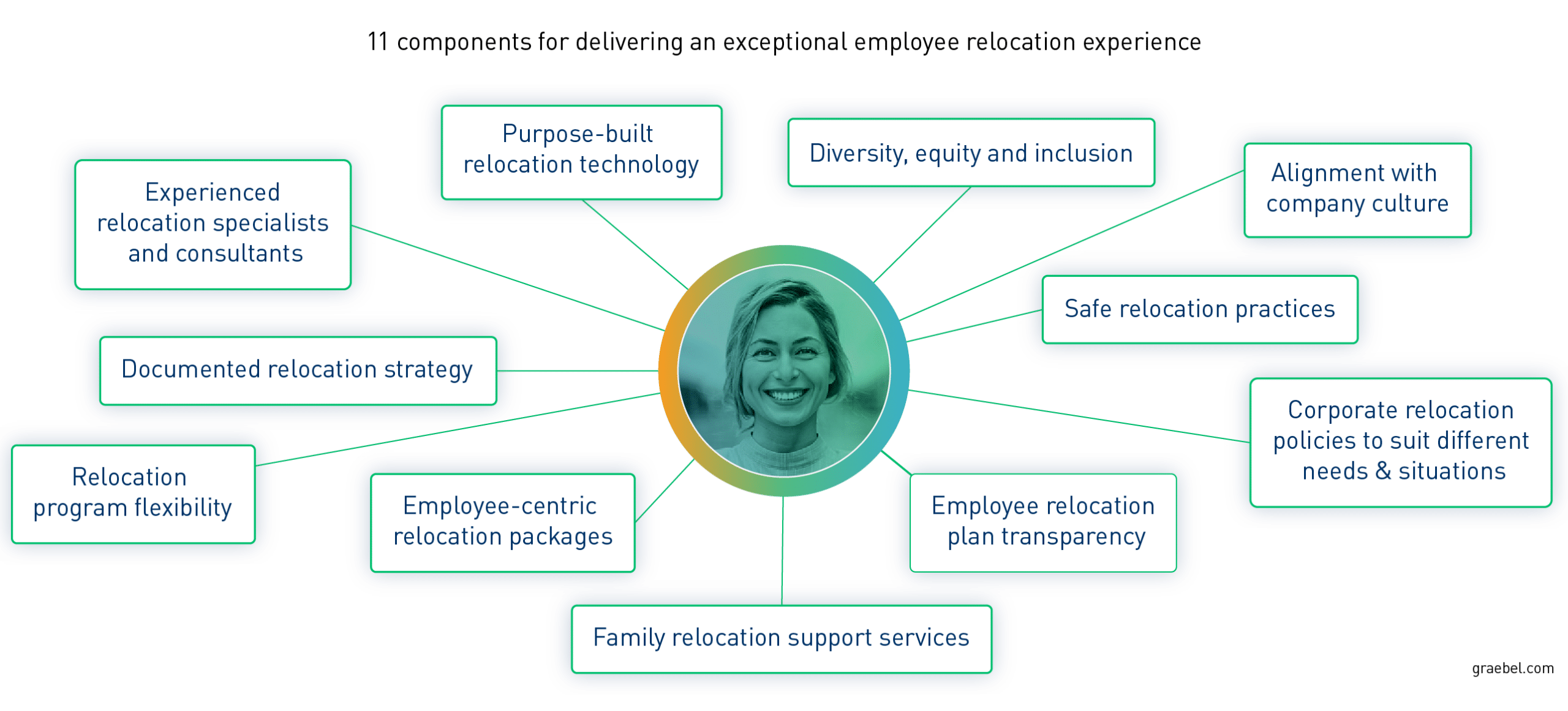
1. Experienced relocation specialists and consultants
Arguably the most important factor in delivering an exceptional employee relocation experience is the relocation specialist or consultant. These individuals coordinate every aspect of the relocation. Specifically, they guide employees throughout the relocation process, advocate on their behalf and act as the single point of contact.
But not all specialists and consultants are created equal. The people who can deliver an experience that meets or exceeds employee expectations are experts in their craft. They also exhibit the following key traits:
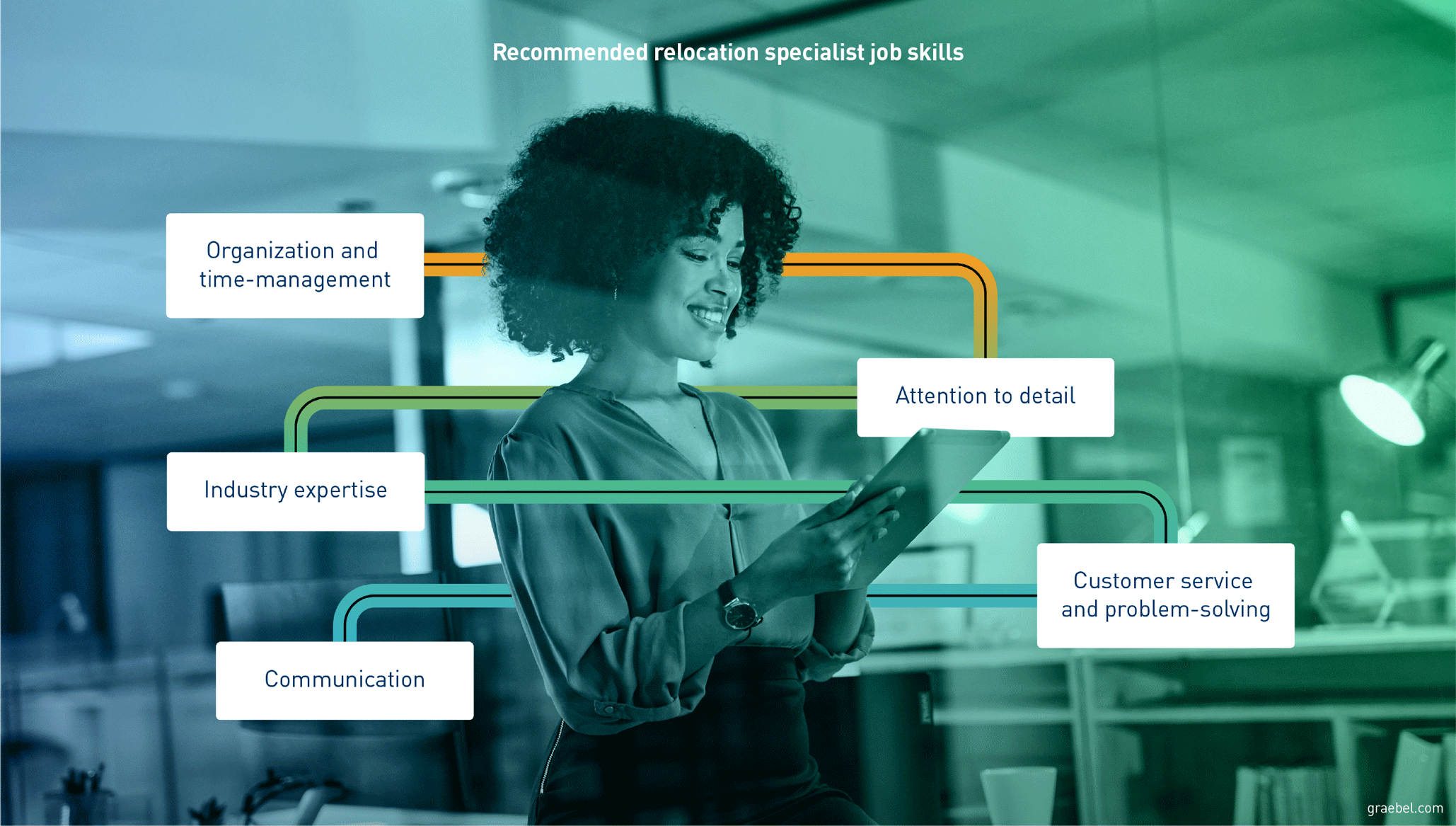
-
Empathy
Listening, acknowledging and displaying a genuine concern for employees’ unique situations and how they feel at each stage in the journey
-
Anticipation and proactive problem-solving
Addressing challenges before they emerge, or before employees are even aware of them
-
Pacing
Providing employees with the right information at the right time to minimize overwhelm
-
Openness and transparency
Ensuring employees understand all parts of the process and remain informed via the communication methods they prefer (e.g. email, phone calls, technology or a combination)
-
Trust
Building genuine relationships and providing honest answers so employees have clarity on everything, including why a request might not be granted
-
Exceeding expectations
Going above and beyond to upgrade, expedite or save employees time and money — all the little extras that employees appreciate but don’t expect
2. Documented relocation strategy
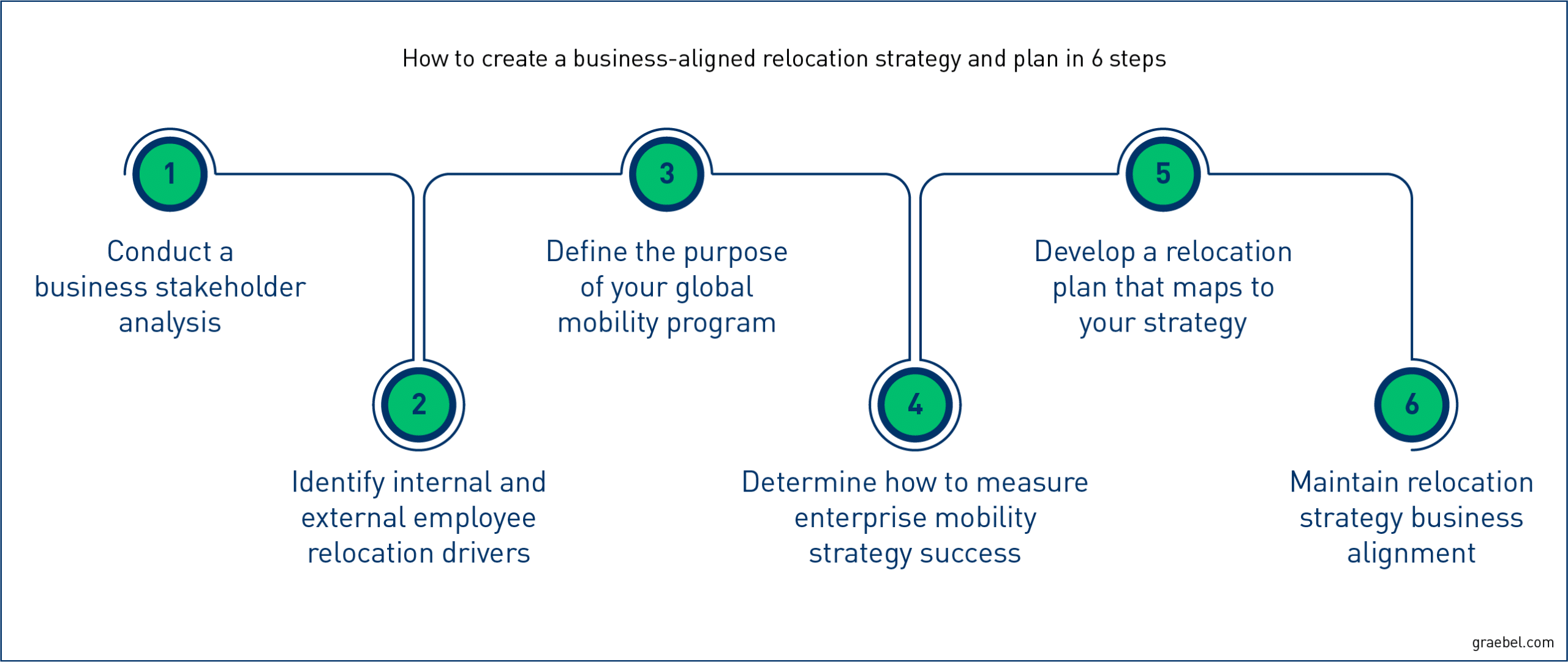
There’s an adage that states, “If you fail to plan, you are planning to fail!” This couldn’t be more true for relocation.
Creating a solid relocation strategy lays the foundation for building an exceptional relocation experience that balances employee expectations with your company’s business needs.
While some companies base their strategy on cookie-cutter templates and standard frameworks, this approach doesn’t always work. To achieve the best results, your relocation strategy needs to be unique to your company’s mission, goals and culture. That’s because creating an exceptional relocation experience involves matching your definition of employee experience with the mobile employee journey. Otherwise, there will be a disconnect between your employees’ day-to-day experience and the reality of the relocation process.
The relocation strategy also needs to connect to your overall business goals and be documented. A written strategy ensures everyone has the same understanding of what the company is trying to achieve. It states clear relocation objectives, outlines specific priorities and helps decision-makers communicate consistently to employees. It also allows you to track and measure results over time. You can determine what’s working and what’s not working to continue to implement changes that make your relocation program better.
3. Corporate relocation policies to suit different needs & situations
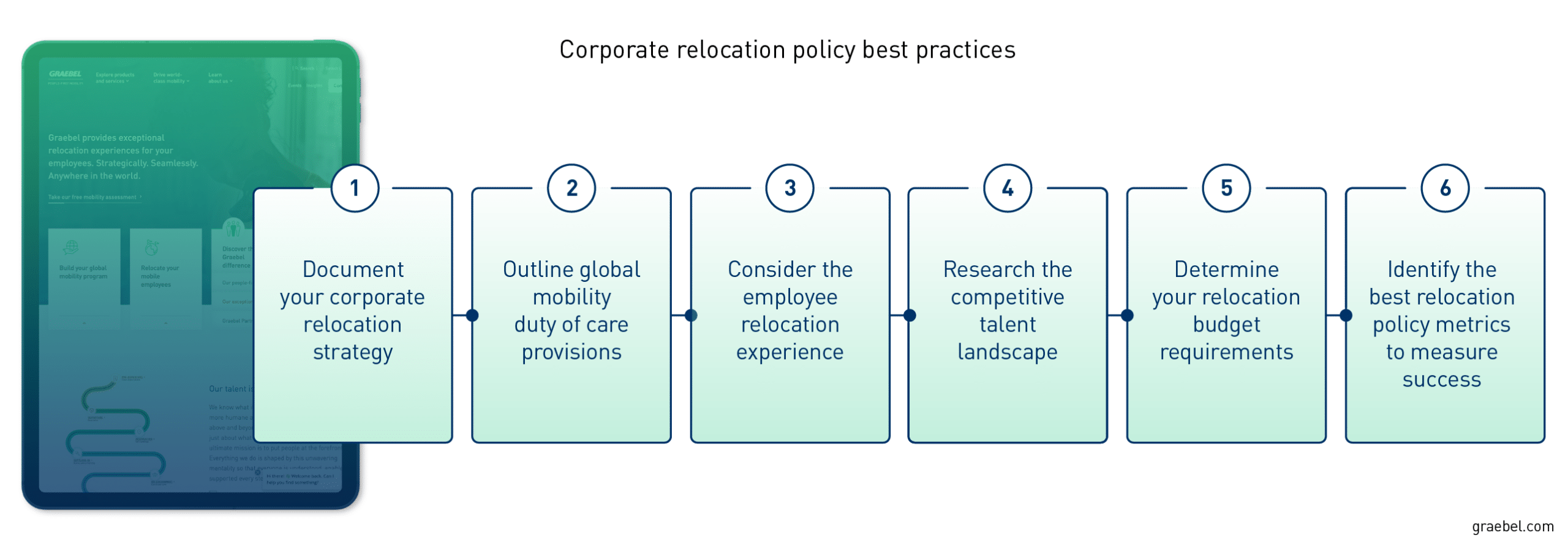
A corporate relocation policy includes the established parameters for various employee roles and personal situations. If your goal is to create an exceptional relocation experience, your organization should also offer different types of policies. For example, there might be a “lump sum policy” for recent grads and a “VIP Policy” for C-level executives.
The relocation policy must also maximize the value for a mobile employee while also controlling costs for the business. For example, by assessing how often exceptions occur within a policy, you can decide on the best course of action. If costly exceptions happen often, it may be best to include them within the policy. This change will cut down on incremental spending for the business and allow for a better employee experience.
Another way of ensuring your corporate relocation policy contributes to an exceptional experience involves counseling mobile employees. Providing expert guidance ensures they understand the policy and how to use the Miscellaneous Expense Allowance (MEA) for services it doesn’t cover. Without this clarity, the likelihood of a negative employee experience increases.
4. Employee-centric relocation packages
A relocation package is a moving assistance benefit given to employees who have accepted a position in another location. Companies typically offer employee relocation packages for two reasons:
-
Attract new talent
A relocation package provides access to a broader pool of qualified candidates. These individuals may not live near your current business location but would be willing to move if given financial assistance. Additionally, since a relocation package is an attractive compensation benefit, it can appeal to candidates interested in career development. While they may not be applying for a remote position, they may want to explore future domestic or international relocation opportunities.
-
Retain and develop employees
When employees receive financial relocation assistance and feel positive about the experience, they are more likely to stay with the organization.
Although a job relocation package is a great incentive, it must be employee-centric rather than corporate-centric to create an exceptional employee relocation experience. This means the package should go beyond providing the bare minimum relocation assistance and offer perks, such as:
- Moving coordination services
- Pre-move visits (to tour schools and see various housing options)
- Housing assistance (buying or selling a home, breaking a lease or providing a security deposit)
- Spousal career assistance
- Travel allowance for home visits
- Storage of excess goods
The goal is to meet employees’ unique needs, reduce stress and make each move as financially viable as possible.
5. Family relocation support services
One of the main reasons assignments end — or even fail to begin — is because they don’t meet the family’s needs. Most mobile employees are more concerned with their partner and dependents’ comfort, safety and happiness than their own.
Unfortunately, many organizations forget to prioritize family engagement and happiness. But putting their needs at the forefront and supporting all members (including pets) is critical. Here are some family relocation support services you can provide to increase the likelihood of delivering an exceptional relocation experience:

-
Communicate early
Speak to family members at the beginning of the relocation process to understand their priorities and concerns. This dialogue will help you find solutions and provide information to put their minds at ease.
-
Build familiarity
Arrange pre-assignment trips for the family to see the new location and get excited about living in a new place. Also, introduce them to others familiar with the city and lifestyle to answer their questions and ease any worries.
-
Set up technology
Establish internet connectivity as soon as the family arrives at their new location. Technology will help reduce feelings of isolation and loneliness by ensuring everyone can:
- Contact friends and family in their home country
- Use maps and other apps to help them adapt to their new environment
- Log into the same software and tools they’re used to
-
Ease transitions
Help make the adjustment easier by recommending housing, schools, transportation, food options and recreational activities similar to their home country.
-
Reduce cultural barriers
Help families learn how to feel more at home by creating opportunities to learn about language, currency, transportation, city life (e.g. how to shop at the local market), local laws and regulations and other important information.
-
Maintain home connections
Arrange for family members to take periodic trips home. Also, facilitate opportunities for direct family members from the home country to visit. These connections will help mitigate loneliness and reduce the chance that the mobile employee will end the assignment prematurely.
-
Support partner career goals or interests
Help the assignee’s partner pursue personal career goals through counseling, job-seeking services and immigration services like work visas. Also, help both partners manage work responsibilities by recommending support services, such as babysitting, shopping, cooking, pet walking or house cleaning. If the assignee’s partner is unable to secure work status in the destination country or chooses not to work, help build connections to other expats or individuals with similar interests to pursue hobbies or volunteer opportunities.
6. Employee relocation plan transparency
An employee relocation plan outlines all of the activities that need to happen at each stage of the relocation journey. Specifically, it includes a list of all of the tasks, who is responsible for completing them and the due dates.
Creating this type of detailed and accessible plan goes a long way towards creating an exceptional relocation experience. After all, when employees can see the full picture, this clarifies the relocation process. Consequently, this helps them feel much calmer during what can be a stressful time.
Additionally, a clear and transparent employee relocation plan minimizes the potential for misunderstandings and complications. From day one, everyone knows the tasks that must be accomplished at each stage of the relocation journey.
7. Relocation program flexibility
A common mistake companies make is trying to create a one-size-fits-all relocation program and implementation process. At first, this may seem like a simple way to manage this type of initiative. But it doesn’t take long before realizing this type of structure doesn’t work.
Assignees in different generations want and expect different benefits. Additionally, they have unique needs and preferences. For example, our State of Mobility 2021 Survey and Report indicates only 21% of Millennial parents are willing to relocate internationally during the pandemic, compared to 35% of parents overall, likely because many Millennial parents have young families to consider.
A rigid approach to employee relocation only results in a negative experience rather than a positive one. For this reason, it’s essential to have enough flexibility built into the relocation program when creating an exceptional experience. This flexibility ensures your program includes what’s most important to assignees and their families while also empowering your workforce mobility team to make decisions.
8. Safe relocation practices
Moving to a new city, state or country is stressful enough. But when employees don’t feel safe, this can heighten anxiety and potentially derail the assignment altogether.
To create an exceptional relocation experience, mobile employees need to feel confident their safety is a priority. No matter what is happening in the world, the following safe relocation practices are critical:
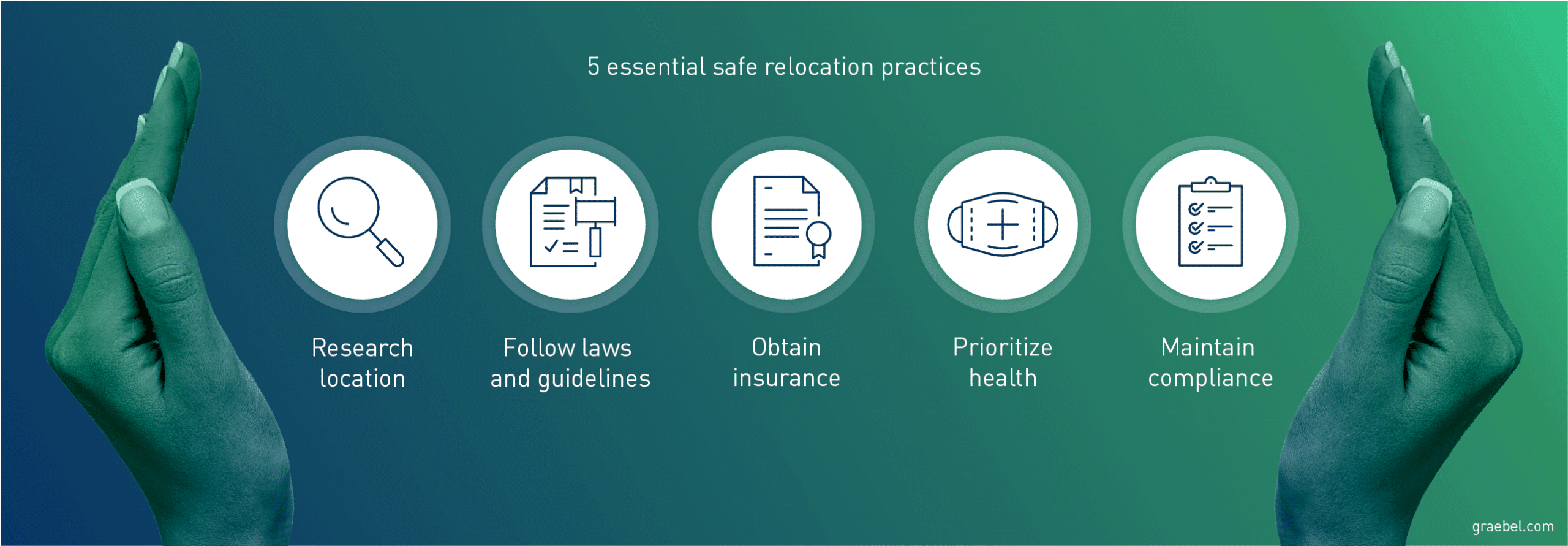
-
Research the location
When you plan to move employees to a new city, it’s critical to ensure the desired location is safe. Examine data and listen to expert advice before determining if a move is safe or relocation is even possible at that time.
-
Follow government laws and guidelines
Governments can change rules and restrictions at any time about who can enter the country. Ensure employees know the official rules required for border authorities and follow them closely.
-
Obtain proper insurance
Unfortunately, circumstances beyond your employees’ control can happen so it’s essential to be safe rather than sorry. Make sure employees have the right travel, health, moving or renter’s insurance to guard against catastrophes that could have significant financial implications.
-
Take protective health measures
To protect mobile employees on assignment, ensure their vaccinations are current or arrange the required shots. Also, with global events or crises like the COVID-19 pandemic, it’s important to understand the impact on mobile employees. It’s also essential to create a crisis plan for your assignees to help ease their concerns.
-
Ensure relocation service provider compliance
Make sure your service providers have proper measures in place to handle any employee health or safety emergencies. Additionally, ensure they follow a code of conduct that aligns with the way you operate your business and protects your employees, including:
- Complying with applicable laws, rules, and regulations
- Following ethical employment practices
- Maintaining business integrity, including abiding by anti-corruption, antitrust, and competition laws
- Ensuring the privacy and security of confidential and proprietary information
- Maintaining safe and healthy work environments
9. Alignment with company culture
When employees accept a role at an organization, a big part of their decision comes down to cultural fit. Employees sign up to be part of a culture that corresponds with their own needs and values. They also expect this culture to carry through every aspect of the company. This means there can’t be a disconnect between the company culture and its workforce mobility program. Otherwise, the relocation experience won’t be exceptional.
This alignment is even more critical when companies work with a relocation management company (RMC). The RMC needs to embody the corporate culture to operate as a natural extension of the team.
Mirroring an organizational culture involves the RMC’s relocation consultant, and anyone helping your employees along the journey, intimately learn about:
- Company background – important brand and industry characteristics
- Key data – public information about your sales, leadership team and employees
- Geographic footprint – details about your global markets and corporate locations
- Market segments – information about the audience you serve
- Purpose and values – attributes that are important to your employee experience
- Relationship expectations – the customer service levels and types of interactions you expect
When mobile employees believe the RMC understands them, this allows for more open and transparent relationships that create a better experience. On the contrary, if an RMC contrasts with existing cultural business norms, this will amplify that a third party is involved. And this could have negative consequences, particularly if employees don’t feel their needs are being met.
10. Philosophy of diversity & inclusion
When companies have more gender, racial and ethnic diversity, they’re more likely to have better than average financial results. So it’s pretty clear that offering more inclusive employee relocation opportunities will benefit employees as well as the organization itself.
Unfortunately, in some organizations, qualified candidates are not considered equally for assignments based on personal characteristics. However, to create an exceptional employee relocation program, there needs to be a shift. Mobility managers must ensure the pool of assignee candidates is not limited by intentional or unintentional bias and discrimination. Instead, assignments should be granted based on merit, skills and qualifications. Additionally, organizations should ensure policy language is inclusive in the way it is written to avoid any of these biases.
11. Purpose-built relocation technology
When it comes to relocation, technology can have a significant impact on the way mobile employees feel about the experience. Specifically, the type of relocation technology, the visibility it provides into the relocation process, and the level of control and customization it offers helps shape their perspective.
For this reason, relocation software needs to align with the way it will be used in each situation — whether a consultant fully manages it, the employee and consultant use it collaboratively or it is completely self-serve. Additionally, the relocation technology needs to make it easy for both assignees and talent mobility professionals to access information, including:
- Policy, destination, expense and move status details
- Relocation activities and associated tasks with due dates
- Intuitive self-serve tools for completing expense reports or other forms
- Real-time reports and business intelligence for enterprise planning and tracking of all relocations 24/7 on a global basis
- Integration with Human Resources Information Systems (HRIS) or Human Capital Management (HCM) systems
- Supplier invoices and program costs for better management and analysis
How to measure an employee relocation experience
Peter Drucker, the founder of modern management, once said: “If you can’t measure it, you can’t improve it.”
This couldn’t be more true, particularly if you want to create an exceptional employee relocation experience. To achieve this goal, you need to figure out how to measure your program. Otherwise, you won’t know how to continue to raise the bar to reach “exceptional” status.
Analytics allow you to uncover patterns and trends that can help deliver a better experience for your assignees and their families. Specifically, there are three types of analytics that can be used to evaluate, validate and choose the best methods for reaching your relocation program goals:
-
Descriptive analytics
Describe what’s happening today in your workforce mobility programs
-
Predictive analytics
Indicate what could happen with your relocation program in the future
-
Prescriptive analytics
Suggest what should happen to create the best employee relocation experience
It doesn’t matter if you’re managing your relocation program in-house or outsourcing it to an RMC. In either case, you need to use these types of analytics to evaluate the technological, physical, cultural and delivery aspects of your mobility program. This process will allow you to determine its strengths and weaknesses so you can continue to make adjustments.
Example: Employee relocation program measurement
One way to use analytics to take your employee experience to the next level is by evaluating assignee satisfaction post relocation through both qualitative and quantitative data analysis.
Quantitative
Quantitative surveys ensure you can collect feedback from everyone involved in the relocation process, including:
- External mobility specialists
- Internal mobility professionals
- Mobile employees and their families
- Partners and suppliers
You should ask these individuals to rate the experience in several relevant categories and then analyze the data. Some of these categories might include:
- Overall satisfaction
- Technology usability
- Temporary and long-term accommodations
- Consultant knowledge and expertise
- Alignment with corporate culture
Qualitative
The second way to measure an employee relocation experience is through qualitative interviews. This method allows you to speak to everyone involved in the process, including external mobility specialists and consultants, partners and suppliers, internal mobility professionals and mobile employees and their families.
Qualitative interviews are important because they provide opportunities to ask questions that can uncover more in-depth insights. The answers you receive allow you to identify specific aspects of the relocation that went well or need improvement. Obtaining this context also enables you to determine if the relocation program meets your goals or if changes are required.
That said, it’s not enough to simply collect feedback. Once you gather the right quantitative and qualitative information, it is essential to take action. This is the only way you’ll be able to improve your relocation program continually to achieve exceptional status.
Why outsourcing relocation elevates the experience
While some companies choose to manage relocation programs in-house, a relocation management company (RMC) can be an asset.
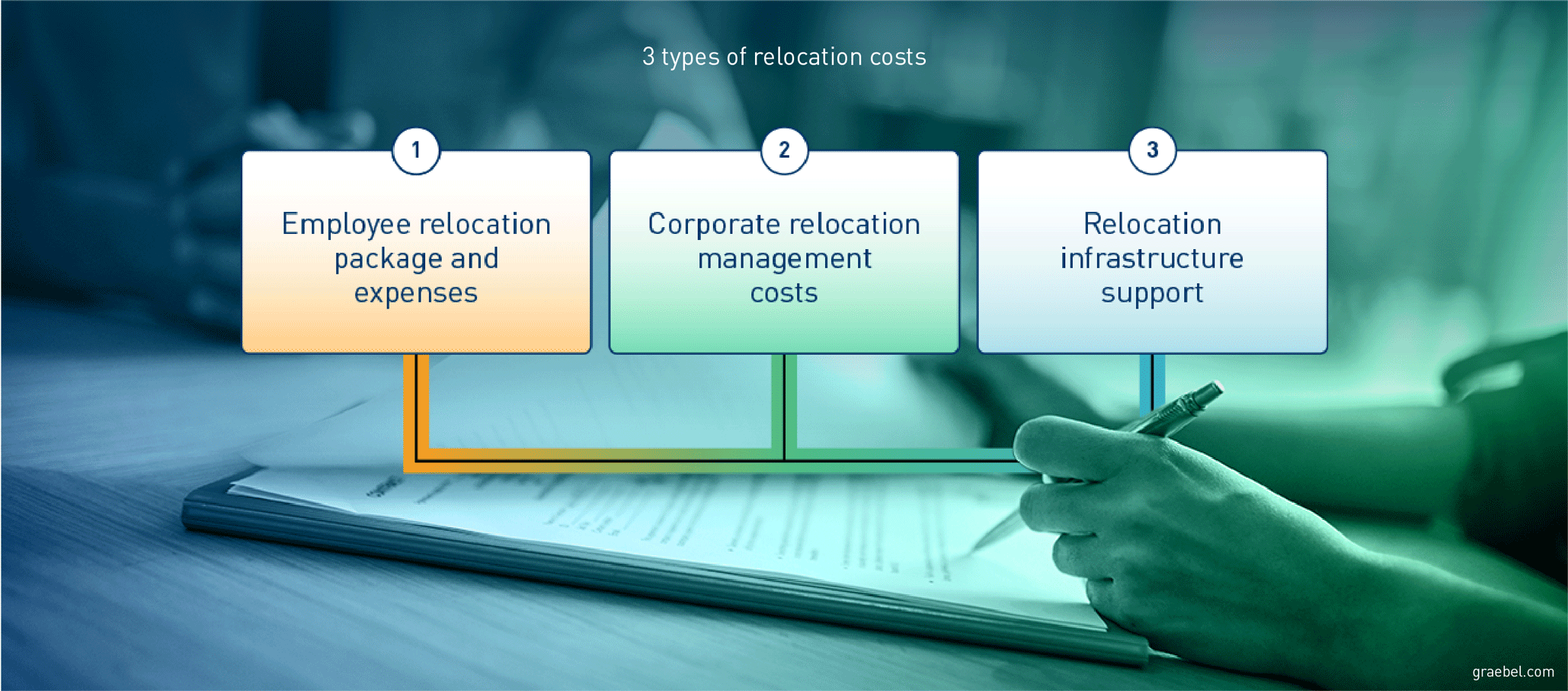
Outsourcing relocation to a company dedicated to providing exceptional employee experiences means you have a team that aligns with your philosophy. Besides this, you have access to tremendous knowledge, scalability and buying power that would be hard to duplicate internally. And when you have this expertise, you can elevate your relocation program, increasing the likelihood your investment will pay off.
Specifically, there are five main benefits of outsourcing to an RMC that is committed to delivering an exceptional employee relocation experience:
-
Dedicated relocation resources
One of the biggest challenges companies face is a lack of staff. Most organizations only have one to five people dedicated to global mobility. This means it’s nearly impossible to juggle the myriad of details required to create a good relocation experience, let alone an exceptional one. In contrast, when you outsource relocation to an RMC, you have a team devoted to meeting your mobile employees’ needs. This single point of care — which can include a global account manager, regional account managers, consultants and associates — allows your employees to have continuous support in any location or time zone.
-
Ability to scale your relocation program
Sometimes you may have more relocations, and sometimes you may have fewer. By outsourcing relocation, you can handle as many or as few moves as necessary at a certain point in time. Outsourcing also reduces your relocation costs because you don’t have to spend time, money or resources hiring internal workforce mobility professionals that you may only need short term.
-
Collective expertise
There is so much to know about managing employee relocation — from policy management to travel logistics to visa and immigration processes. When you don’t specialize in these areas, you don’t know what you don’t know. There are many advantages of using a relocation management company that handles hundreds, or even tens of thousands, of employee relocations each year. An RMC combines best practices, collective experience and a worldwide network of team members and suppliers to deliver everything you and your employees need. An RMC can also take on all program administration for you, including:
- Complete mobility program management
- Service delivery management
- Supplier management, including invoice audits and payment
- Financial services management
-
Vast relocation supplier network
When you’re relocating employees, you need partners in the right locations to provide services and advice. But a quality, cost-effective supply chain doesn’t come from managing a handful of relocations a year. Outsourcing relocation to an RMC allows you to access top-tier suppliers that meet quality standards, compliance requirements and budgets. This ensures you get the highest quality service for the lowest cost to provide an exceptional relocation experience to your employees.
-
Holistic view
There are so many people involved in an employee relocation that it can be hard to know if the program is functioning the way it should. By outsourcing to an RMC, you get higher-level insights into how talent mobility, HR, suppliers and partners work together. This information allows you to not only provide an exceptional relocation experience but offer the best employee experience overall.
Essential services for an exceptional relocation
People-first corporate relocation services are at the heart of providing an exceptional employee relocation experience. When you provide services that cover every aspect of the relocation process, this increases your ability to exceed employee expectations.
Specifically, it is essential to have corporate relocation services that cover the following three areas:
-
Shaping your relocation program
These services align your mobility strategy with company and employee relocation needs, the corporate culture, and your definition of employee experience. Examples of these services include:
- Mobility strategy consulting and planning
- Relocation program management
- Program implementation and training
-
Supporting your mobile employees
These services help guide employees throughout the relocation journey — no matter their role, policy, location, communication preferences or move type. Examples of these services include:
- Pre-decision counseling
- Departure coordination
- Destination management
- Settling-in assistance
- On-assignment support
- Repatriation logistics and management
-
Serving your business needs
These services involve overseeing relocation program measurement and reporting, financial management and compliance and effective communication. Examples of these services include:
- Program measurement and reporting
- Financial management
- Compliance alignment
Take your employee relocation experience from good to exceptional
Explore our journey map to discover how exceptional moments create exceptional employee experiences.